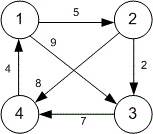Розбір
In this problem you must construct a matrix of the shortest paths between all pairs of vertices in a graph. To do this, the Floyd-Warshall algorithm should be implemented.
Example
The graph described in the problem statement is as follows:

Algorithm realization
Store the adjacency matrix of the graph in the array .
#define MAX 101 int g[MAX][MAX];
The floyd function implements the Floyd — Warshall algorithm.
void floyd(void)
{
int i, j, k;
for(k = 0; k < n; k++)
for(i = 0; i < n; i++)
for(j = 0; j < n; j++)
if (g[i][k] + g[k][j] < g[i][j]) g[i][j] = g[i][k] + g[k][j];
}The main part of the program. Read the input graph.
scanf("%d",&n);
for(i = 0; i < n; i++)
for(j = 0; j < n; j++)
scanf("%d",&g[i][j]);Run the Floyd — Warshall algorithm.
floyd();
Print the matrix of the shortest distances between all pairs of vertices.
for(i = 0; i < n; i++)
{
for(j = 0; j < n; j++)
printf("%d ",g[i][j]);
printf("\n");
}Java realization
import java.util.*;
public class Main
{
static int g[][];
static int n;
static void floyd()
{
for(int k = 0; k < n; k++)
for(int i = 0; i < n; i++)
for(int j = 0; j < n; j++)
if (g[i][k] + g[k][j] < g[i][j])
g[i][j] = g[i][k] + g[k][j];
}
public static void main(String[] args)
{
Scanner con = new Scanner(System.in);
n = con.nextInt();
g = new int[n][n];
for(int i = 0; i < n; i++)
for(int j = 0; j < n; j++)
g[i][j] = con.nextInt();
floyd();
for (int i = 0; i < n; i++)
{
for (int j = 0; j < n; j++)
System.out.print(g[i][j] + " ");
System.out.println();
}
con.close();
}
}Python realization
The floyd function implements the Floyd — Warshall algorithm.
def floyd():
for k in range(n):
for i in range(n):
for j in range(n):
if g[i][k] + g[k][j] < g[i][j]:
g[i][j] = g[i][k] + g[k][j]The main part of the program. Read the input graph.
n = int(input()) g = [[] for _ in range(n)] for i in range(n): g[i] = list(map(int, input().split()))
Run the Floyd — Warshall algorithm.
floyd()
Print the matrix of the shortest distances between all pairs of vertices.
for i in range(n): print(*g[i])